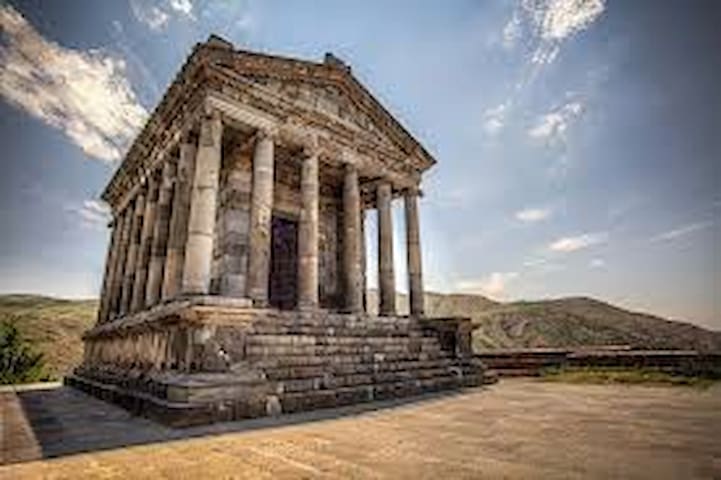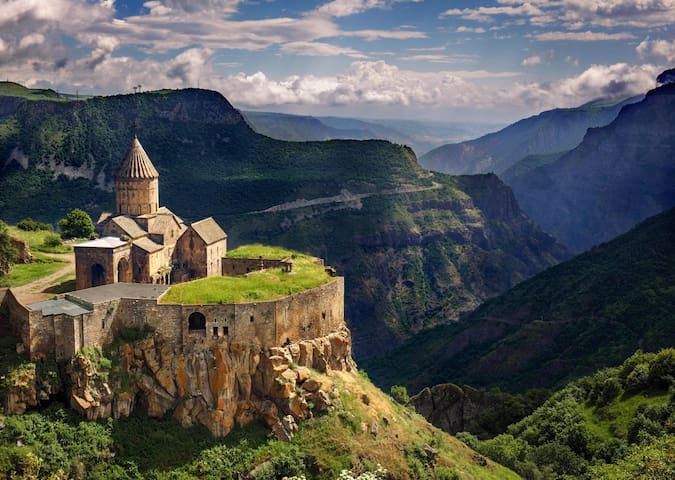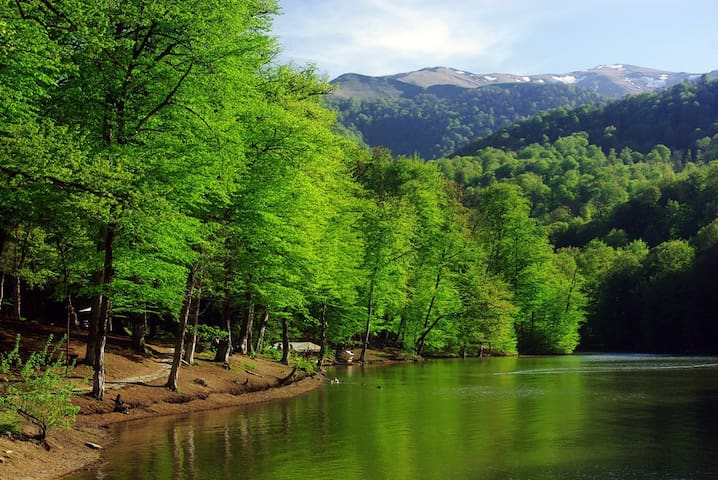ancient church
Geghard (Armenian: Գեղարդ, meaning "spear") is a medieval monastery in the Kotayk province of Armenia, being partially carved out of the adjacent mountain, surrounded by cliffs. It is listed as a UNESCO World Heritage Site with enhanced protection[1] status.
While the main chapel was built in 1215, the monastery complex was founded in the 4th century by Gregory the Illuminator at the site of a sacred spring inside a cave. The monastery had thus been originally named Ayrivank (Այրիվանք), meaning "the Monastery of the Cave". The name commonly used for the monastery today, Geghard, or more fully Geghardavank (Գեղարդավանք), meaning "the Monastery of the Spear", originates from the spear which had wounded Jesus at the Crucifixion, allegedly brought to Armenia by Apostle Jude, called here Thaddeus, and stored amongst many other relics. Now it is displayed in the Echmiadzin treasury.
45 ντόπιοι το προτείνουν
Μονή Γκεγκάρντ
Geghard (Armenian: Գեղարդ, meaning "spear") is a medieval monastery in the Kotayk province of Armenia, being partially carved out of the adjacent mountain, surrounded by cliffs. It is listed as a UNESCO World Heritage Site with enhanced protection[1] status.
While the main chapel was built in 1215, the monastery complex was founded in the 4th century by Gregory the Illuminator at the site of a sacred spring inside a cave. The monastery had thus been originally named Ayrivank (Այրիվանք), meaning "the Monastery of the Cave". The name commonly used for the monastery today, Geghard, or more fully Geghardavank (Գեղարդավանք), meaning "the Monastery of the Spear", originates from the spear which had wounded Jesus at the Crucifixion, allegedly brought to Armenia by Apostle Jude, called here Thaddeus, and stored amongst many other relics. Now it is displayed in the Echmiadzin treasury.
Etchmiadzin Cathedral is the mother church of the Armenian Apostolic Church, located in the city of Vagharshapat, Armenia. According to most scholars it was the first cathedral built in ancient Armenia, and is often considered the oldest cathedral in the world.The original church was built in the early fourth century[33]—between 301 and 303 according to tradition—by Armenia's patron saint Gregory the Illuminator, following the adoption of Christianity as a state religion by King Tiridates III. It was built over a pagan temple, symbolizing the conversion from paganism to Christianity. The core of the current building was built in 483/4 by Vahan Mamikonian after the cathedral was severely damaged in a Persian invasion. From its foundation until the second half of the fifth century, Etchmiadzin was the seat of the Catholicos, the supreme head of the Armenian Church.
15 ντόπιοι το προτείνουν
Mother See of Holy Etchmiadzin
1 Araratyan StreetEtchmiadzin Cathedral is the mother church of the Armenian Apostolic Church, located in the city of Vagharshapat, Armenia. According to most scholars it was the first cathedral built in ancient Armenia, and is often considered the oldest cathedral in the world.The original church was built in the early fourth century[33]—between 301 and 303 according to tradition—by Armenia's patron saint Gregory the Illuminator, following the adoption of Christianity as a state religion by King Tiridates III. It was built over a pagan temple, symbolizing the conversion from paganism to Christianity. The core of the current building was built in 483/4 by Vahan Mamikonian after the cathedral was severely damaged in a Persian invasion. From its foundation until the second half of the fifth century, Etchmiadzin was the seat of the Catholicos, the supreme head of the Armenian Church.
The Temple of Garni (Armenian: Գառնիի տաճար, Gaṙnii tačar, [ˈgɑrnii ˈtɑtʃɑʁ])[a] is the only standing Greco-Roman colonnaded building in Armenia and the former Soviet Union. Built in the Ionic order in the village of Garni, Armenia, it is the best-known structure and symbol of pre-Christian Armenia.
The structure was probably built by king Tiridates I in the first century AD as a temple to the sun god Mihr. After Armenia's conversion to Christianity in the early fourth century, it was converted into a royal summer house of Khosrovidukht, the sister of Tiridates III. According to some scholars it was not a temple but a tomb and thus survived the destruction of pagan structures. It collapsed in a 1679 earthquake. Renewed interest in the 19th century led to excavations at the site in early and mid-20th century, and its eventual reconstruction between 1969 and 1975, using the anastylosis method. It is one of the main tourist attractions in Armenia and the central shrine of Armenian neopaganism.
29 ντόπιοι το προτείνουν
Garni
The Temple of Garni (Armenian: Գառնիի տաճար, Gaṙnii tačar, [ˈgɑrnii ˈtɑtʃɑʁ])[a] is the only standing Greco-Roman colonnaded building in Armenia and the former Soviet Union. Built in the Ionic order in the village of Garni, Armenia, it is the best-known structure and symbol of pre-Christian Armenia.
The structure was probably built by king Tiridates I in the first century AD as a temple to the sun god Mihr. After Armenia's conversion to Christianity in the early fourth century, it was converted into a royal summer house of Khosrovidukht, the sister of Tiridates III. According to some scholars it was not a temple but a tomb and thus survived the destruction of pagan structures. It collapsed in a 1679 earthquake. Renewed interest in the 19th century led to excavations at the site in early and mid-20th century, and its eventual reconstruction between 1969 and 1975, using the anastylosis method. It is one of the main tourist attractions in Armenia and the central shrine of Armenian neopaganism.
The Tatev Monastery (Armenian: Տաթևի վանք Tat'evi vank') is a 9th-century Armenian Apostolic monastery located on a large basalt plateau near the Tatev village in Syunik Province in southeastern Armenia. The term "Tatev" usually refers to the monastery. The monastic ensemble stands on the edge of a deep gorge of the Vorotan River. Tatev is known as the bishopric seat of Syunik and played a significant role in the history of the region as a center of economic, political, spiritual and cultural activity.
In the 14th and 15th centuries, the monastery hosted one of the most important Armenian medieval universities, the University of Tatev, which contributed to the advancement of science, religion and philosophy, reproduction of books and development of miniature painting. Scholars of the Tatev University contributed to the preservation of Armenian culture and creed during one of its most turbulent periods in its history.
The monastery is the "best-known site" in Syunik.[1] Wings of Tatev, a cableway from Tatev to Halidzor village was opened in October 2010.[2][3] It was included in the Guinness World Records as world's "longest non-stop double track cable car."[4]
52 ντόπιοι το προτείνουν
Μονή Τατέβ
H45The Tatev Monastery (Armenian: Տաթևի վանք Tat'evi vank') is a 9th-century Armenian Apostolic monastery located on a large basalt plateau near the Tatev village in Syunik Province in southeastern Armenia. The term "Tatev" usually refers to the monastery. The monastic ensemble stands on the edge of a deep gorge of the Vorotan River. Tatev is known as the bishopric seat of Syunik and played a significant role in the history of the region as a center of economic, political, spiritual and cultural activity.
In the 14th and 15th centuries, the monastery hosted one of the most important Armenian medieval universities, the University of Tatev, which contributed to the advancement of science, religion and philosophy, reproduction of books and development of miniature painting. Scholars of the Tatev University contributed to the preservation of Armenian culture and creed during one of its most turbulent periods in its history.
The monastery is the "best-known site" in Syunik.[1] Wings of Tatev, a cableway from Tatev to Halidzor village was opened in October 2010.[2][3] It was included in the Guinness World Records as world's "longest non-stop double track cable car."[4]
Sightseeing
Located in downtown Yerevan, the avenue is mainly home to luxurious residential buildings, high-end branded shops, commercial offices, coffee shops, hotels, restaurants, and nightclubs.Although it was planned by the main architect of Yerevan Alexander Tamanian in 1924, the actual plan was never implemented during the Soviet period. A decade after the collapse of the Soviet Union, the Yerevan City Council decided to set for the construction of the avenue. According to the original plans, the National Gallery and the History Museum at Republic Square were never meant to be built on the current location, so Northern Avenue ends near their building, rather than opening directly into Republic Square.
Northern Avenue
Hyusisayin poghotaLocated in downtown Yerevan, the avenue is mainly home to luxurious residential buildings, high-end branded shops, commercial offices, coffee shops, hotels, restaurants, and nightclubs.Although it was planned by the main architect of Yerevan Alexander Tamanian in 1924, the actual plan was never implemented during the Soviet period. A decade after the collapse of the Soviet Union, the Yerevan City Council decided to set for the construction of the avenue. According to the original plans, the National Gallery and the History Museum at Republic Square were never meant to be built on the current location, so Northern Avenue ends near their building, rather than opening directly into Republic Square.
Lake Parz (Armenian: Պարզ Լիճ) is a small lake located in the Dilijan National Park east of Dilijan in Armenia. The lake was formed by natural climatic changes. "Parz" in Armenian means clear.
In 2017 the TransCaucasian Trail was created to connect Parz Lake with the town of Dilijan and in the opposite direction with Gosh Village and Gosh Lake. The trail was created through the building of new trail segments to connect existing trails or dirt roads together.
In 2018 Trails For Change NGO has built a new trail that loops around the Lake.
At the Lake you will find a restaurant, bar, paddle boats ropes course and zip lines
23 ντόπιοι το προτείνουν
Lake Parz
Lake Parz (Armenian: Պարզ Լիճ) is a small lake located in the Dilijan National Park east of Dilijan in Armenia. The lake was formed by natural climatic changes. "Parz" in Armenian means clear.
In 2017 the TransCaucasian Trail was created to connect Parz Lake with the town of Dilijan and in the opposite direction with Gosh Village and Gosh Lake. The trail was created through the building of new trail segments to connect existing trails or dirt roads together.
In 2018 Trails For Change NGO has built a new trail that loops around the Lake.
At the Lake you will find a restaurant, bar, paddle boats ropes course and zip lines




